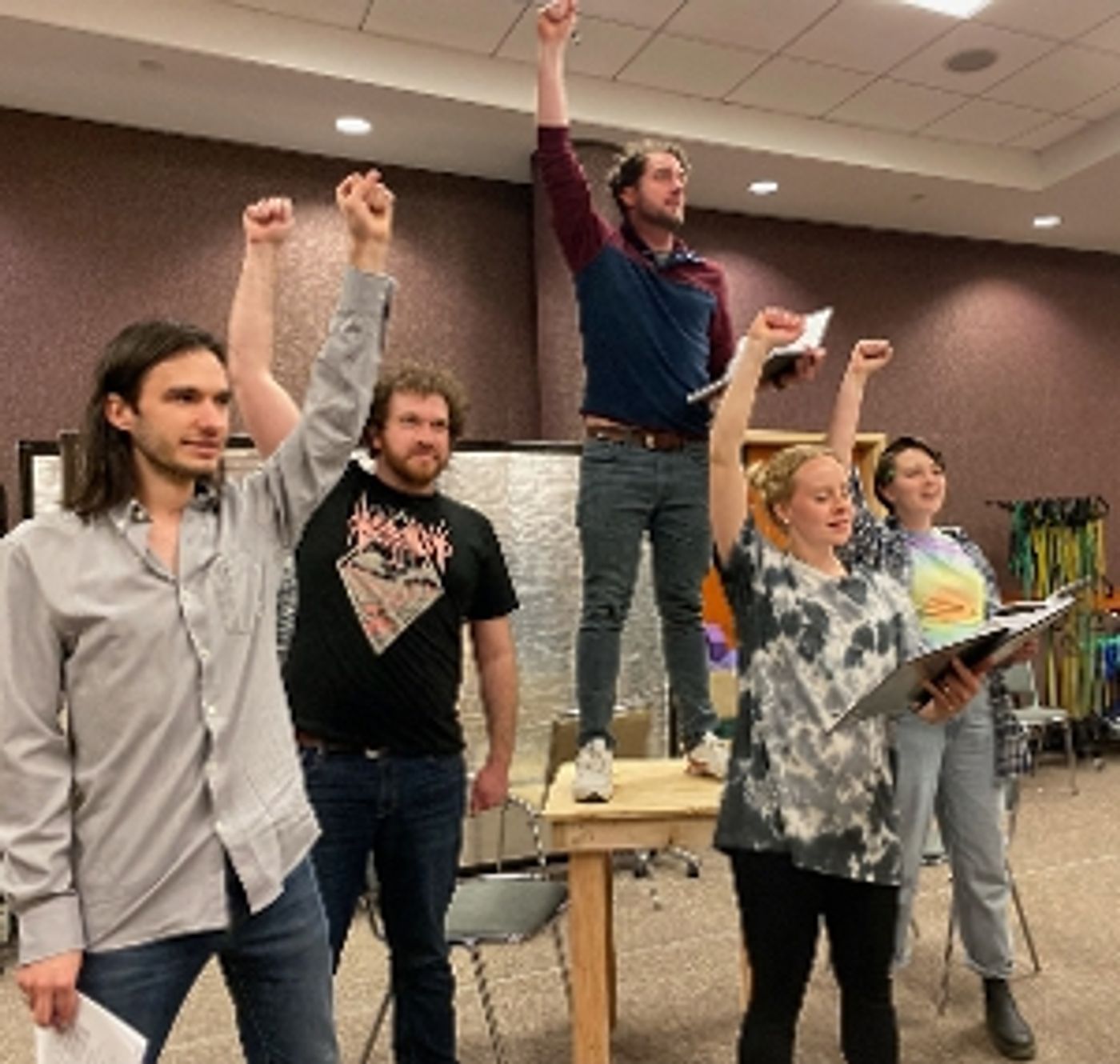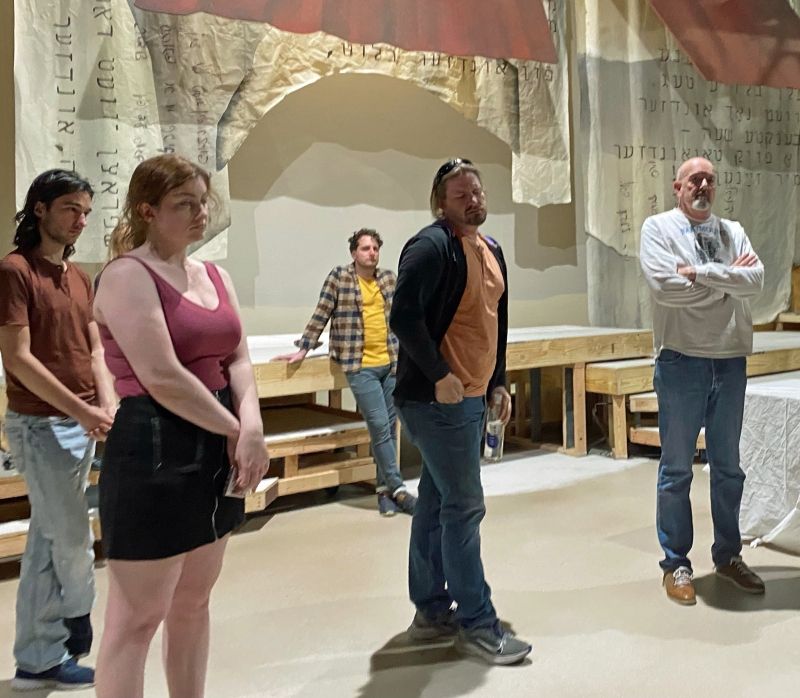Feature: VILNA: A FORGOTTEN RESISTANCE at White Theatre
Lithuanian fighters resist the Nazis during WWII

"Vilna: A Resistance Story" is a new musical theater composition by Kevin and Allison Cloud with a book by Lisa Kenner Grissom. It tells the unfamiliar story of the roughly hundred thousand Vilna Jews before and during the Nazi Holocaust period.
The full two-act play faces its first ever six audiences at the White Theatre inside the Jewish Community Center in Overland Park beginning Saturday April 22 at 7:30 p.m.
The Vilna resistance came to the attention of Kansas City composers Kevin and Allison Cloud when they found a poem by a young Lithuanian WWII era partisan named Hirsch Glick. Glick did not survive the war, but his poem became lyric to an existing Russian folk song. "Never Say" became an anthem for Resistance groups through the end of World War II Curiosity led the Clouds to discovery of the Vilna history.
Vilna (the show) is a somewhat unlikely construction produced in collaboration with Kansas City's "Culture House" production and educational organization and the Jewish Community Center.
Most Americans of Jewish ancestry are descended from Eastern European (Ashkenazi) stock, but the story of the Vilna Jews is not very well known in the United States. This can be attributed to its geographic location in Lithuania, the southernmost of the Baltic countries.
Over a half million American Jews served in the United States military during World War II, but American troops never crossed into most of the former Soviet Union. Remarkably, the extermination of Lithuanian Jews mainly by the Einsatzgruppen (mobile killing squads) may have been the most complete murder of Jews in all the European countries.
Vilna (now called Vilnius) in Lithuania is the capitol city. Prior to World War II, Vilna grew into an educational and cultural center with a Jewish plurality population. More than forty percent of the population identified as Jewish with the largest remaining population groups split between Catholic and Russian Orthodox congregations. Vilna had become known as the Jerusalem of Eastern Europe.
Vilna governance seesawed between Poland, the Russian Empire, and brief Lithuanian independences in the years prior to the second war. Just before the Nazi invasion of Poland in 1939, Russian foreign minister Molotov agreed to carve up Poland with his German counterpart Joachim Von Ribbentrop. In exchange for a promise not to resist the German invasion, the Russians and the Germans each annexed a portion of Poland and Lithuania.
The Russians were even then skeptical of their German neighbors. A large portion of the industrial base and many of the Jewish residents were relocated to more easily defendable locations further inside the Soviet area.
The Germans attacked the Soviet Union on June 1, 1941. Russian troops withdrew from Vilna and the German army (Wehrmacht) just marched into the city. This play explores the fate of the tens of thousands of Jewish residents who remained. Almost eighty thousand Jews died from this one population.
The German military established two ghettos at Vilna and used most of the inhabitants as the slave labor manufactors of German war material. The majority of the population went along with their captors and a Jewish administration. Most residents believed that the pragmatic Germans could not afford to act differently than dozens of conquerors over hundred of years. The idea of total extermination was beyond credulity to them. A small group of young intellectuals intuited the real goal of the Nazis and prepared to revolt.
The resistance group (called the UPO) negotiated with the leaders of more mainstream groups to join them. The large majority of Jews chose not to take military action. Their history of success in Vilna lulled them into the false belief that the Germans would allow them to survive if they cooperated.
Without general community agreement, The UPO agreed to withhold kinetic action inside the city. The main population agreed to protect their identities. But the Resistance still prepared to attack.
As time passed, groups of Jews were rounded up and taken from the city. They were told they would work in other locations. This was a lie. Instead, many were transported to a picnic facility a few miles from Vilna in the Ponar(y) Forest. Up to several thousand at a time were executed by Einsatzgruppe killing squads and buried in pre-dug pits. These actions are similar to what happened at the more well-known Babi-Yar execution ground near Kiev Ukraine.
Operation Barbarosa, the Germans attack on Russia, was ultimately repelled by Soviet forces after a long siege at Leningrad. As the Germans retreated, the Vilna ghettos were liquidated in 1943.
A small portion of the UPO resistance group escaped through the Vilna sewer system before joining up with Russian partisan groups and forming a Jewish Partisan brigade. The combined forces harassed retreating Germans until the Partisans and the Soviet Army retook the city in mid 1944.

With the exception of a few hundred fighters, the entire Jewish population of Vilna disappeared. Today, a single temple and about five thousand Jews remain in Vilna.
Many of the characters portrayed in "Vilna: A Resistance Story" are historic people. Some survived the war. Many emigrated to the infant state of Israel, helped others to re-establish their lives in Palestine, and fought heroically in the 1948 Israeli War of Independence. The last of the partisans passed away after a full life in 2012.
Tickets for "Vilna: A Resistance Story" are available online or through the box office at the Jewish Community Center in Overland Park.
Photos provided by Kevin Cloud.
Videos

